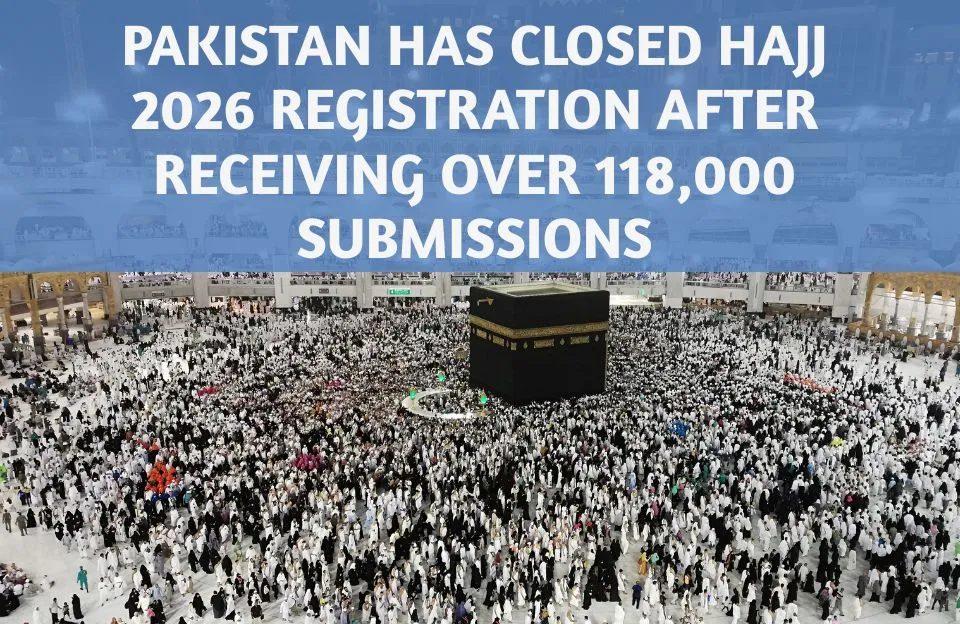Introduction
The Government of Pakistan has Hajj 2026 registration completed, a target achieved in remarkably little time. The Ministry of Religious Affairs and Interfaith Harmony declared the cessation of the application window upon receiving an overwhelming 118,060 applications under the government scheme. This near total of the government allotment of 119,210 pilgrims showcases extraordinary demand along with a well-structured submission procedure. The registration closure marks a key phase in the country’s preparations for the yearly pilgrimage, demonstrating effective and speedy governance. This document aims to elaborate on the application procedure starting from the policies up to the final numbers with all the relevant timelines and pathways that triggered the accelerated completion of hajj 2026 registration.
The Context of Hajj 2026 Registration in Pakistan
For the upcoming Hajj in 2026, the total number of pilgrims allocated to Pakistan by the Kingdom of Saudi Arabia is 179,210. Of note, this number is split between the government-sponsored Hajj scheme and the private tour operators. The federal cabinet’s approval of Hajj Policy 2026 included a key decision regarding the allocation of seats. The government scheme received the lion’s share with 119,210 seats while the private operators received the rest of 60,000 seats. This adjustment was made in light of the private sector’s significant undervaluation of their quota prior, allowing more pilgrims to benefit from the government-supported scheme. The unprecedented hajj 2026 registration Pakistan government scheme’s registration cut off showcases the government trust as well as the effectiveness of the new policies. The strong response almost filled every single seat, with only a few slots left. The high submission rate demonstrates a new benchmark for efficiency in the application process.
The Phased Approach to Registration for Hajj 2026
To control the large number of incoming pilgrims, the government set up a structured, orderly, two-step system for processing applications. The initial phase of the hajj 2026 registration opened on August 4, 2025, and was only for those who preregistered with the Ministry of Religious Affairs and Interfaith Harmony prior to the application deadline. During this period that lasted until August 9, the ministry received over 71,000 applications. It is apparent that there was a large number of those who had been planning for the pilgrimage and were willing to apply the moment the opportunity arose.
After the first phase, a second phase was announced for the registration of hajj 2026, which started on August 11, 2025. This phase was available to both pre-registered and newly unregistered individuals, and submissions were processed in a strict “first-come, first-serve” manner. This method was aimed to fill the remaining seats in the government quota as fast as possible. Initially, this phase was set to end on August 16, but then was extended by a few days for certain banks in order to accommodate a final surge of applicants. This approach was so successful that the Ministry was able to announce much earlier than expected the complete registration closure for hajj 2026, which confirmed that the quota was almost fully met. The speed of response during this phase highlighted the extraordinary supply and demand of the pilgrimage and highlighted the efficiency of the system used by the government.
The Mechanism of Hajj 2026 Online Registration
Similar to other countries, we have embraced an almost fully digitized system, slowly replacing traditional methods used for applications with a hybrid system consisting of designated branches of banks and an official online portal. As for the hajj 2026 registration, the online portal was especially useful for intending pilgrims, especially those who are proficient with technology. Using the online portal, applicants were able to complete their forms from the comfort of their homes, create a Payment Slip ID (PSID), and then pay the required first installment at one of the 14 designated banks. The hajj 2026 online registration was not only an improvement to the application process, but its efficiency and effectiveness was greatly shaped by this method.
The specific banks remained the backbone of the entire process, serving all users, be it those who came in person or those who submitted applications online. The banks were to process the applications on a “first-come, first-served” basis, and to cease further processing as soon as the quota was reached. This chaotic but controlled duplication enabled the completion of the hajj 2026 registration in an orderly manner throughout the country. The online portal and the banks combined received a high number of applications in a very short period, which allowed the process to be completed early. The sheer volume of applications received through both channels, especially during the second phase, illustrated the success of the government’s approach to try and simplify the process. This balanced strategy was critical in enabling the flood of applications to be processed within the limited timeframe.
The Official Hajj 2026 Dates and Deadlines
The Ministry of Religious Affairs has been preparing the schedule for the hajj 2026 dates for quite some time now. For registrants of the first stage, the cut-off date was set as August 9. For users in the second stage, the official portal ceased taking applications at midnight on August 16. However, the cut-off date for banks was changed to offer some flexibility for the last surge of users to apply on a “first-come, first-serve” basis. This port was simply to utilize the additional users and complete the preset number of travellers for the government sponsored trip. The first step of the process started on July 4, 2025, and the last step on August 9 saw a lot of change for everyone that was pre-registered. For these users, the last date was in August. These outlined dates would allow everyone to upload the necessities to be pre-set for alongside the application upload, greatly easing the hassle for travellers.
Ultimately, the deadline received applications was August 23, 2025, as the Ministry confirmed the quota was met and no further applications would be processed. This response streamlined the period set for registration for hajj 2026, and the period was significantly shorter than in previous years. This was clearly an effect of the overwhelming public response. Completing the application phase means the next key date for the selected pilgrims in 2026 is November this year, when they are expected to pay the second installment of their hajj fare. This swift resolution of the registration process enables the Ministry to efficiently manage all subsequent arrangements for the pilgrimage, ensuring every selected pilgrim enjoys a hassle-free and meticulously organized Hajj. The Ministry’s decision to finalize the application process after meeting the quota illustrates the strong commitment to the principles of public administration. It upholds functional public governance by ensuring operation and fidelity to the principles of transparency and efficiency.
Conclusion
The fact that the registration process of hajj 2026 has closed early in Pakistan is clearly a sign of the country’s love for the religious pilgrimage as well as the impact of the new policy on Hajj introduced by the government. With 118060 applications already received, the government scheme has almost maximized its quota of 119210 seats as well, showing a positive reception by the public. Intensive public response is attributed to the new refined two-step approach that combines online submissions via the bank and in-person.



